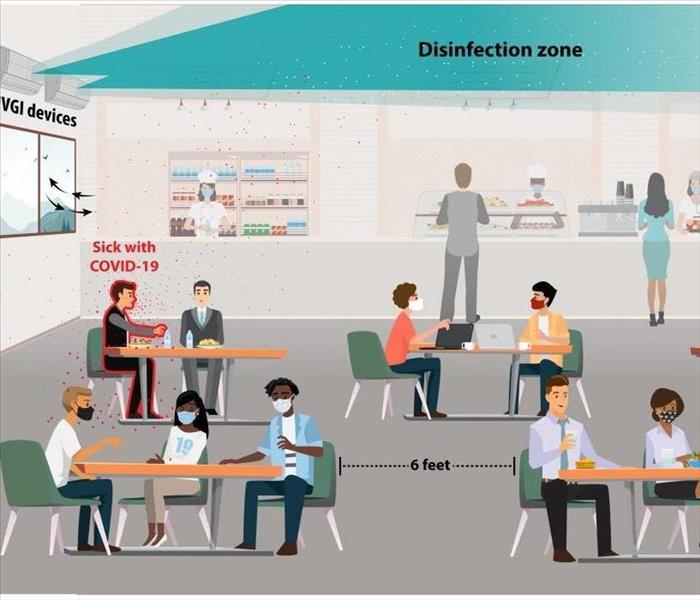COVID-19 & Commercial Ventilation (HVAC)
3/17/2022 (Permalink)
What response has your commercial building taken to combat COVID-19? Sanitizing stations, increased cleaning protocols, mask-wearing, & physical distance is no doubt a few your building implemented. With most protocols lessening, is there a way to limit the risk of exposure in your commercial building?
HVAC & Commercial Ventilation
Here are some tips from the CDC to increase your building's ventilation.
The following tools identify ways to improve ventilation:
- Increase the introduction of outdoor air:
- Open outdoor air dampers beyond minimum settings to reduce or eliminate HVAC air recirculation. In mild weather, this will not affect thermal comfort or humidity. However, this may be difficult to do in cold, hot, or humid weather, and may require consultation with an experienced HVAC professional.
- Open windows and doors, when weather conditions allow, to increase outdoor air flow. Do not open windows and doors if doing so poses a safety or health risk (e.g., risk of falling, triggering asthma symptoms) to occupants in the building. Even a slightly open window can introduce beneficial outdoor air.
- Use fans to increase the effectiveness of open windows:
- To safely achieve this, fan placement is important and will vary based on room configuration. Avoid placing fans in a way that could potentially cause contaminated air to flow directly from one person to another (see FAQ below on indoor use of fans). One helpful strategy is to use a window fan, placed safely and securely in a window, to exhaust room air to the outdoors. This will help draw outdoor air into the room via other open windows and doors without generating strong room air currents. Similar results can be established in larger facilities using other fan systems, such as gable fans and roof ventilators.
- Ensure ventilation systems operate properly and provide acceptable indoor air quality for the current occupancy level for each space.
- Rebalance or adjust HVAC systems to increase total airflow to occupied spaces when possible.
- Turn off any demand-controlled ventilation (DCV) controls that reduce air supply based on occupancy or temperature during occupied hours. In homes and buildings where the HVAC fan operation can be controlled at the thermostat, set the fan to the “on” position instead of “auto,” which will operate the fan continuously, even when heating or air-conditioning is not required.
- Improve central air filtration:
- Increase air filtration to as high as possible without significantly reducing design airflow. Increased filtration efficiency is especially helpful when enhanced outdoor air delivery options are limited.
- Make sure air filters are properly sized and within their recommended service life.
- Inspect filter housing and racks to ensure appropriate filter fit and minimize air that flows around, instead of through, the filter.
- Ensure restroom exhaust fans are functional and operating at full capacity when the building is occupied.
- Inspect and maintain exhaust ventilation systems in areas such as kitchens, cooking areas, etc. Operate these systems any time these spaces are occupied. Operating them even when the specific space is not occupied will increase overall ventilation within the occupied building.
- Use portable high-efficiency particulate air (HEPA) fan/filtration systems to enhance air cleaning (especially in higher risk areas such as a nurse’s office or areas frequently inhabited by people with a higher likelihood of having COVID-19 and/or an increased risk of getting COVID-19). See the FAQ below on HEPA filters and portable HEPA air cleaners. (Note: Portable air cleaners that use filters less efficient that HEPA filters also exist and can contribute to room air cleaning. However, they should be clearly labeled as non-HEPA units.)
- Generate clean-to-less-clean air movement by evaluating and repositioning as necessary, the supply louvers, exhaust air grilles, and/or damper settings. See the FAQ below on Directional Airflow. This recommendation is easier to accomplish when the supply and exhaust points are located in a ceiling grid system.
- Use ultraviolet germicidal irradiation (UVGI) as a supplemental treatment to inactivate SARS-CoV-2 when options for increasing room ventilation and filtration are limited. Upper-room UVGI systems pdf icon[6.1 MB, 87 pages] can be used to provide air cleaning within occupied spaces, and in-duct UVGI systems can help enhance air cleaning inside central ventilation systems.
- In non-residential settings, run the HVAC system at maximum outside airflow for 2 hours before and after the building is occupied.
[All information is provided by the CDC]
When a disaster strikes, SERVPRO® is here to help. Call SERVPRO® of Downey for your disaster recovery needs. From Fire and Water Damage to sanitization, we are there to assist you. Call us at: (562) 392-3007






 24/7 Emergency Service
24/7 Emergency Service
